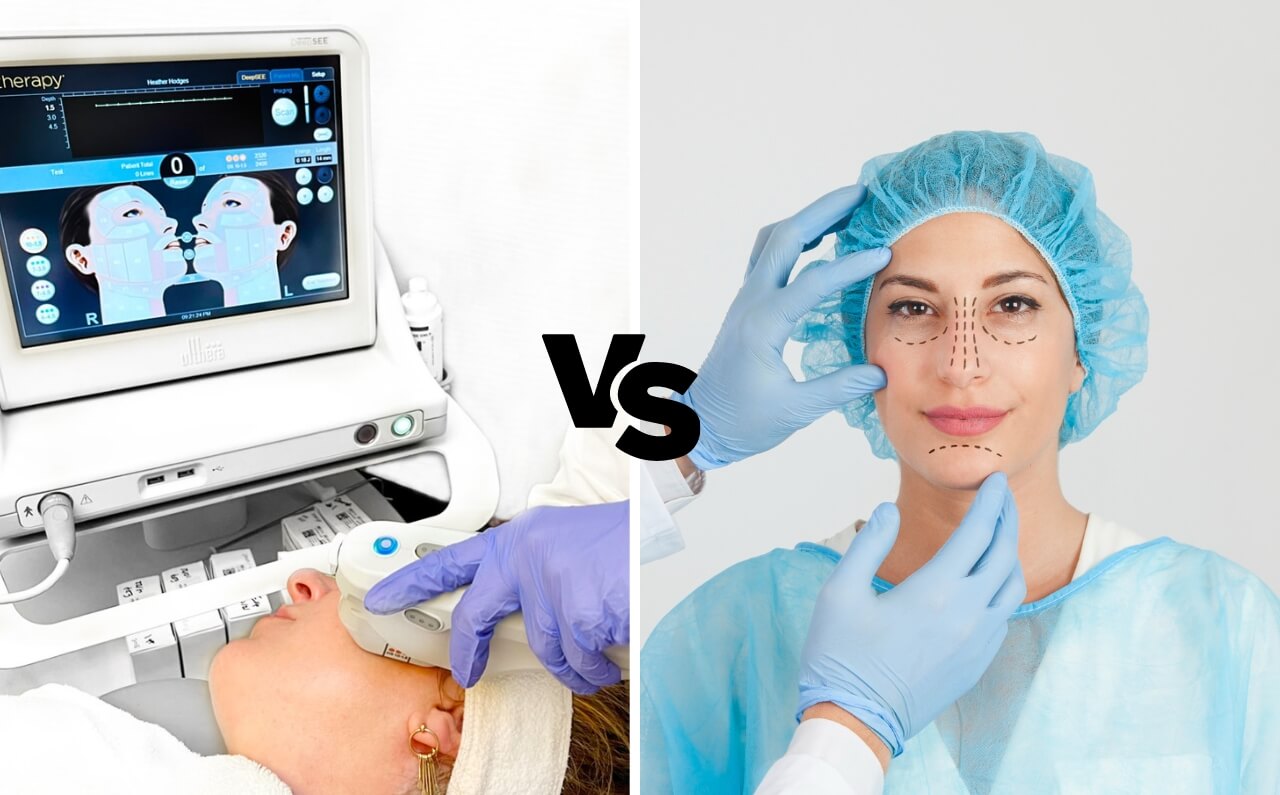Non-surgical cosmetic procedures have been on the rise in recent years. With advancements in technology and a growing interest in maintaining youthful appearances, individuals increasingly seek minimally invasive options to rejuvenate their skin and enhance their features.
There are many forms of non-surgical treatments, including injectables, laser therapy, and skin tightening procedures. These options have gained attention due to their ability to deliver impressive aesthetic improvements with minimal discomfort and downtime.
Ultherapy is another non-surgical procedure to achieve a lifted and youthful skin. And today, we’ll be looking into the distinctive differences between Ultherapy and surgical facelifting to give you an overview of the two.
What is a Surgical Facelift?

Before we jump right into the differences between the two – we need to have an understanding of the differences between surgical facelifts and Ultherapy.
A surgical facelift, also known as rhytidectomy, is a cosmetic procedure that aims to give the face a more youthful appearance. This surgical approach addresses various signs of aging by removing excess skin, tightening underlying tissues, and repositioning the skin on the face and neck. A facelift can effectively reduce the appearance of wrinkles, sagging skin, and other age-related changes.
However, due to the nature of the procedure, a facelift often poses potential risks such as scarring. It’s important to consult with your medical professionals to discuss any other potential complications before committing to the procedure.
What is Ultherapy Procedure?

Ultherapy is a non-invasive cosmetic procedure that uses focused ultrasound energy to lift and tighten the skin naturally without surgery. Approved by the FDA, it is for facial rejuvenation treatment for those looking for minimal downtime and less invasive alternatives.
Ultherapy employs focused ultrasound energy to target the deeper layers of the skin. Unlike lasers, which penetrate the skin from the outside, ultrasound goes deeper, reaching the foundational layers of the skin, including the same layers typically adjusted during a surgical facelift. This triggers natural collagen production, leading to a gradual tightening and lifting of the skin.
Benefits of Ultherapy

Ultherapy treatments appeal to many due to their many benefits. These are:
- Non-invasive with no downtime: One of the most significant benefits of Ultherapy is that it requires no incisions, which means no recovery time is necessary.
- Natural results: As Ultherapy stimulates the body’s own collagen production, the results appear more natural than some surgical outcomes, and there is no risk of looking “overdone.”
- Safety: Ultherapy has been used globally for over a decade and is FDA-cleared for lifting the skin on the neck, chin, and brow.
- Versatility: It can be used as a standalone treatment or in conjunction with other therapies, making it a flexible option for many patients.
Key Differences Between Ultherapy and Surgical Facelift

Now that we have some form of understanding of surgical facelifts and Ultherapy, we can look at the differences between the two treatments and make a comparison.
When deciding between Ultherapy and a surgical facelift, it’s crucial to understand their key differences in terms of invasiveness, recovery, longevity of results, effectiveness for specific concerns, and cost. These factors can significantly influence which procedure is more suitable for your aesthetic goals and lifestyle.
Invasiveness and Downtime
- Ultherapy: This procedure is non-invasive with no incisions or need for anesthesia. Ultherapy sessions typically last around 30 to 90 minutes, depending on the treatment area. Patients can resume normal activities immediately after treatment, making it ideal for those who cannot take time off for surgery recovery.
- Surgical Facelift: As a surgical procedure, facelifts involve incisions, usually around the hairline and ears, and require anesthesia. The surgery can last several hours. Recovery time is significant, typically requiring two to four weeks before returning to normal activities and up to several months for all swelling to subside and the final results to fully appear.
Duration of Results
- Ultherapy: The effects of Ultherapy continue to improve over the course of 2-3 months following the treatment as new collagen develops. The results can last up to two years, although this varies based on the individual’s skin quality and aging process. Maintenance treatments can extend the effects.
- Surgical Facelift: The results of a surgical facelift are more dramatic and can last for up to ten years or more. Since the procedure involves physically removing excess skin and tightening tissues, the effects are longer-lasting compared to non-invasive methods.
Targeted Concerns and Effectiveness
- Ultherapy: Best suited for mild to moderate skin laxity, Ultherapy is effective for lifting and tightening the skin on the neck, under the chin, and the eyebrows. It also improves lines and wrinkles on the upper chest. However, it is less effective on advanced skin sagging and may not replace the need for surgery in older individuals with more significant signs of aging.
- Surgical Facelift: This is the most effective method for addressing moderate to severe facial sagging and volume loss. A facelift can redefine the jawline, remove deep wrinkles, and correct sagging in the midface and neck area. It is particularly effective for older patients or those with considerable skin laxity.
Cost Comparison
- Ultherapy: Generally less expensive than a facelift due to its non-invasive nature. The cost varies depending on the treatment area but typically ranges from $2,000 to $5,000 per session.
- Surgical Facelift: Much more expensive, reflecting its complexity and effectiveness. Costs can vary widely depending on the geographic location, the surgeon’s expertise, and the extent of the surgery, but they typically range from $7,000 to $15,000 or more.
Ultherapy and surgical facelifts cater to different needs and preferences. Ultherapy offers a non-invasive, less costly, and no-downtime option suitable for early signs of ageing, while surgical facelifts provide a more long-term solution for significant ageing effects but require a greater financial commitment and recovery period.
Choosing the Right Option for You
Deciding between Ultherapy and a surgical facelift involves considering various factors that can influence the effectiveness and satisfaction with the results. Understanding these considerations can guide individuals toward making the best choice for their aesthetic goals.
Factors to Consider When Deciding Between Ultherapy and a Surgical Facelift

- Age and Skin Condition: Younger individuals or those with mild to moderate skin laxity may find Ultherapy effective for their needs, while older individuals or those with significant sagging might benefit more from the comprehensive results of a surgical facelift.
- Desired Results: Consider how dramatic a change is desired. Ultherapy offers subtle improvements and can be ideal for those seeking natural enhancement without drastic changes. A surgical facelift, on the other hand, provides more significant and noticeable alterations.
- Recovery Time: If downtime is a concern due to professional or personal responsibilities, Ultherapy may be preferable as it involves no recovery period. A surgical facelift requires a more considerable recovery time, with several weeks needed for initial healing.
- Longevity of Results: For longer-lasting results, a surgical facelift is superior. Ultherapy requires maintenance treatments every couple of years to extend the efficacy of the results.
- Risk Tolerance: Non-invasive treatments like Ultherapy come with fewer risks and side effects, making them suitable for those who are risk-averse. Surgical options, while generally safe when performed by a qualified surgeon, carry the typical risks associated with surgery such as scarring, infection, and longer recovery periods.
Consultation with a Qualified Practitioner!
If you’re still struggling with deciding between surgical facelifts and Ultherapy, Dr Abby Clinic can help guide you toward the decision!
Book a consultation with us and our LCP-certified medical professionals and licensed therapists will help to give the best decision which suits your goals, skin, and budget!





